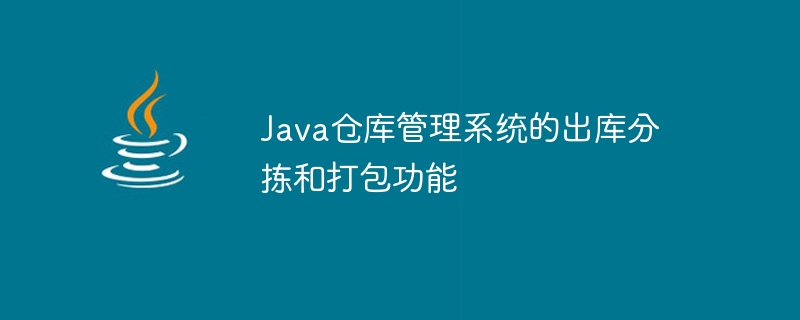Home >Java >javaTutorial >Outbound sorting and packaging functions of Java warehouse management system
Outbound sorting and packaging functions of Java warehouse management system
- 王林Original
- 2023-09-25 14:09:071007browse

The outbound sorting and packaging functions of Java warehouse management system require specific code examples
In recent years, with the rapid development of the logistics industry and the rapid development of e-commerce With the rise of logistics industry, warehouse management system has become an indispensable part of the modern logistics industry. In these systems, outbound sorting and packaging functions are one of the important links in warehouse management. This article will use Java language as an example to introduce how to implement a basic outbound sorting and packaging function, and provide specific code examples.
Outbound sorting is one of the most critical links in the warehouse management process. During the outbound sorting process, goods need to be taken out of the warehouse according to order requirements and sorted according to certain rules. In the Java warehouse management system, an order class and a product class can be used to represent orders and products to realize the outbound sorting function.
First, we create an order class (Order), which contains the following attributes: order number, shipping address, product list, etc. The code example of the order class is as follows:
public class Order {
private String orderId;
private String address;
private List<Product> productList;
// 构造方法、Getter和Setter等省略...
}Next, we create a product class (Product), which contains the following attributes: product number, product name, product quantity, etc. The code example of the product category is as follows:
public class Product {
private String productId;
private String name;
private int quantity;
// 构造方法、Getter和Setter等省略...
}During the outbound sorting process, we need to sort according to the number of the goods in the order and package the sorted goods. This process can be achieved by using Map. The specific code example is as follows:
public class Warehouse {
private Map<String, List<Product>> products = new HashMap<>();
public void sort(Order order) {
List<Product> productList = order.getProductList();
for (Product product : productList) {
String productId = product.getProductId();
// 判断仓库中是否存在该商品
if (products.containsKey(productId)) {
products.get(productId).add(product);
} else {
List<Product> newProductList = new ArrayList<>();
newProductList.add(product);
products.put(productId, newProductList);
}
}
}
public void pack() {
for (String productId : products.keySet()) {
List<Product> productList = products.get(productId);
System.out.println("商品编号:" + productId);
System.out.println("商品数量:" + productList.size());
System.out.println("打包完成!
");
}
}
}In the above code, we created a warehouse class (Warehouse), which has a Map data structure containing the product number and product list to store the sorting results. In the sort method, we traverse according to the number of each item in the order, and add the item to the list of items with the corresponding number. In the pack method, we traverse the sorted product list, print out the product number and quantity on the console, and simulate the packaging process.
Finally, we use these classes to implement an example of outbound sorting and packaging:
public class Main {
public static void main(String[] args) {
// 创建一个订单对象
Order order = new Order();
order.setOrderId("123456");
order.setAddress("上海市");
// 添加商品到订单中
List<Product> productList = new ArrayList<>();
productList.add(new Product("P001", "商品1", 10));
productList.add(new Product("P002", "商品2", 5));
productList.add(new Product("P001", "商品1", 8));
order.setProductList(productList);
// 创建一个仓库对象
Warehouse warehouse = new Warehouse();
// 进行出库分拣
warehouse.sort(order);
// 进行打包
warehouse.pack();
}
}By running the above sample code, we can see that in the print results of the console, The product list is grouped by product number and displays the quantity of each product, simulating the process of outbound sorting and packaging.
In actual warehouse management systems, outbound sorting and packaging functions are often more complex and involve more functions such as inventory management and distribution. However, the above code examples can help readers understand how to implement outbound sorting and packaging functions in the Java warehouse management system, and expand and optimize according to actual needs.
The above is the detailed content of Outbound sorting and packaging functions of Java warehouse management system. For more information, please follow other related articles on the PHP Chinese website!
Related articles
See more- Learning tutorial on void method in Java programming
- Detailed introduction to the summary of common problems in Java programming
- How about java programming ideas
- How to use Java to implement the quality traceability and brand assurance functions of the warehouse management system
- How to use Java to implement multimedia data management and display functions of warehouse management systems

